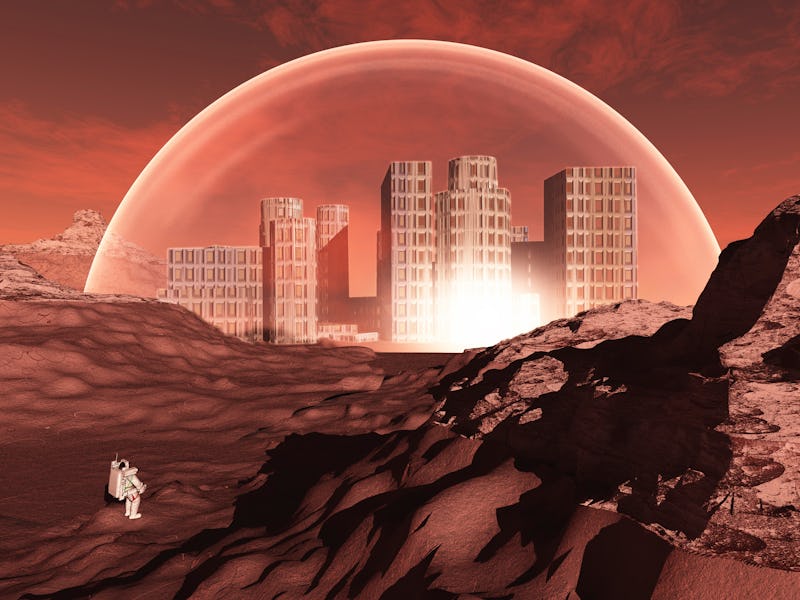Mars City: Researchers find a way to make buildings with dirt and urine
These so-called “space bricks” can be used to construct building-like structures on Mars.

The famous Russian rocket scientist Konstantin Tsiolkovsky once said, “Earth is the cradle of humanity, but one cannot remain in the cradle forever.” Tsiolkovsky is often hailed as one of the fathers of rocketry and cosmonautics and remembered for believing in the dominance of humanity throughout space, also known as anthropocosmism. His work in the late-19th and early-20th centuries helped shape space exploration several decades before humanity first walked on the Moon.
The second half of Tsiolkovsky’s famous quote refers to not just living on the Earth but relying on it as we venture farther out into the cosmos. Even today, as the International Space Station orbits above at 28,000 kilometers per hour (17,500 miles per hour), those astronauts require constant resupply from the ground to stay alive. Future astronauts on the Moon might only have to wait three days to receive supplies from Earth, but as we move farther out into space, especially to Mars, this reliance will undoubtedly become far more tedious, time-consuming, and costly. Therefore, if humanity is to establish a long-term presence in space, we have to learn to use the on-hand resources we have at our disposal.
A team of researchers from the Indian Institute of Science (IISc), in collaboration with the Indian Space Research Organisation (ISRO), has developed a sustainable method for making bricks out of Martian soil, using bacteria and urea. Mammals, including humans, are the primary producers of urea. Because they secrete urea as the primary nitrogenous waste product, they are called ureotelic animals. Urea serves an important role in the metabolism of nitrogen-containing compounds by animals. These so-called “space bricks” can be used to construct building-like structures on Mars that could facilitate human settlement on the Red Planet.
The method for making these space bricks was published in PLOS One. A slurry is first created by mixing Martian soil (simulant) with guar gum, a bacterium called Sporosarcina pasteurii, urea, and nickel chloride (NiCl2). This slurry can be poured into molds of any desired shape, and over a few days, the bacteria convert the urea into crystals of calcium carbonate. These crystals, along with biopolymers secreted by the microbes, act as the cement holding the soil particles together. An advantage of this method is the reduced porosity of the bricks, which has been a problem with other methods used to consolidate Martian soil into bricks.
“The bacteria seep deep into the pore spaces, using their own proteins to bind the particles together, decreasing porosity and leading to stronger bricks,” says Aloke Kumar, Associate Professor in the Department of Mechanical Engineering at IISc, one of the senior authors of the paper.
The group plans to investigate the effect of Mars’ atmosphere and low gravity on the strength of the space bricks. The Martian atmosphere is 100 times thinner than Earth’s atmosphere and contains over 95% carbon dioxide, which may significantly affect bacterial growth. The researchers have constructed a device called MARS (Martian AtmospheRe Simulator), which consists of a chamber that reproduces the atmospheric conditions found on Mars in the lab.
In-Situ Resource Utilization
The IISc study published in PLOS One is based on a practice known as in-situ resource utilization (ISRU), which refers to generating products from local materials or essentially living off the land. As stated earlier, the farther humanity ventures out into space, the more important it will be to generate products from local materials as resupplies from Earth will be tedious, time-consuming, and costly. The European Space Agency is currently working on the ISRU Demonstration Mission, whose goal is to show, by 2025, that water or oxygen production on the Moon is feasible. NASA’s Lunar Surface Innovation Initiative will also develop and demonstrate technologies to use the Moon’s resources to produce water, fuel, and other supplies as well as capabilities to excavate and construct structures on the Moon.
ISRU system concept for autonomous robotic excavation and processing of Mars soil to extract water for use in exploration missions.
Indian Institute of Science
The Indian Institute of Science is a public, deemed, research university for higher education and research in science, engineering, design, and management. It is located in Bengaluru, in the Indian state of Karnataka. The IISc Department of Mechanical Engineering conducts research in areas such as Biomechanics and Medical Devices; Fluid Mechanics and Flow Physics; Heat Transfer and Energy Systems; Manufacturing and Materials; Mechanics of Solids and Structures; Mechanisms, Designs, and Optimization; Micro- and Nanoscale Processes and Devices; Robotics and Autonomous Systems; and Vibrations, Acoustics, and Control. Nitin Gupta, who is the second author of the study, is a Ph.D. student in the IISc Department of Mechanical Engineering whose research focuses on mechanical and materials characterization of bio-consolidates, made up of lunar soil regolith, using techniques such as XRD, micro-CT, SEM, UTM, TGA, and high-rate testing.
What will future ISRU studies reveal about how we can live and work in outer space for the long term? Only time will tell, and this is why we science!
This article was originally published on Universe Today by LAURENCE TOGNETTI. Read the original article here.
This article was originally published on